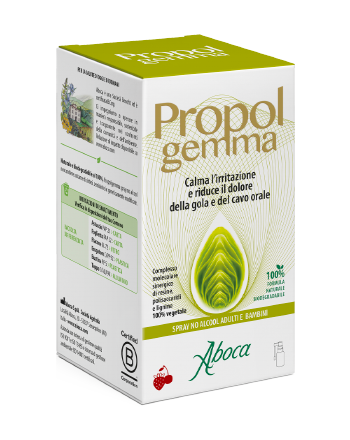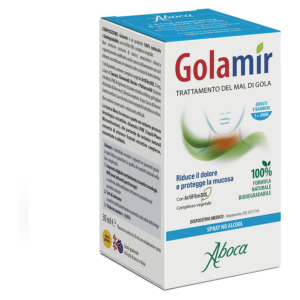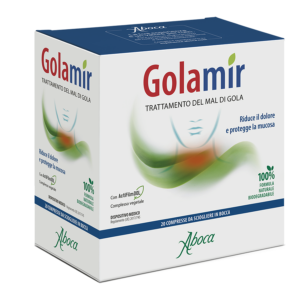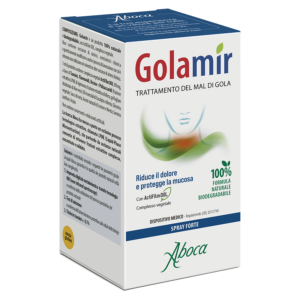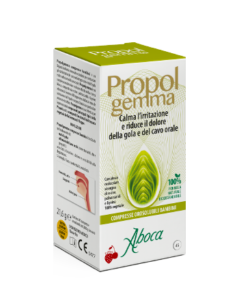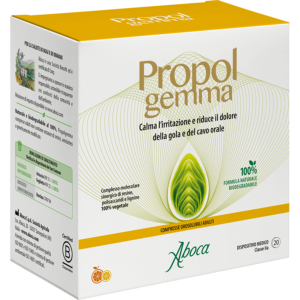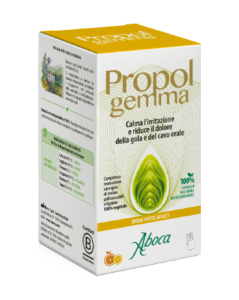Propolgemma Alcohol-Free Spray
Protects the mucosa, soothing irritation and reducing pain in the throat and oral cavity
The entire Products section of this website is an English translation of the official Italian Aboca website. It contains the list of Aboca products marketed in Italy and their related details. Please be aware that the information contained in each product data sheet is in accordance with Italian law only and may not reflect the legislation, regulations or other requirements applicable in your country.
Learn more
Propolgemma is a molecular complex produced by Aboca research and composed of resins, polysaccharides and lignins obtained from black poplar buds, whose resin is used by bees to produce European Propolis.
Thanks to a specific multifraction extraction process Propolgemma is characterised by the presence of the typical components of propolis along with functional compounds derived from the plant tissue of poplar buds. This gives the molecular complex developed by Aboca research special protective properties that are beneficial for the oral mucosa.
INSTRUCTIONS
Propolgemma Alcohol-Free Spray is indicated for the treatment of sore throats and ailments of the oral cavity (such as stomatitis, mouth ulcers and gingivitis) associated with soreness, pain, and sensitivity while swallowing.
It can also be used for minor lesions of the mouth such as those caused by dental treatments or by the use of braces and dentures.
The product can also be used for prevention in all cases where there is exposure to aggressive or irritant external agents (low temperatures, smoke, smog).
Recommended for use from 3 years of age.
HOW IT WORKS
The resinous fraction and the fraction that abounds in polysaccharides and lignins, act synergically to form a protective barrier on the inflamed mucosa which, combined with the antioxidant properties of the flavonoids, indirectly counteracts the inflammation.
This active protective layer soothes soreness, reduces hypersensitivity, alleviates discomfort and facilitates swallowing.
Read the warnings and instructions for use carefully.
Instructions for use
Shake the bottle before use. The package contains the nozzle in a sealed bag. When using for the first time, remove the aluminium cap from the bottle and insert the nozzle. Using the applicator provided, administer 2 nebulizations into the oral cavity up to 2 times a day in children; 4 nebulizations in the oral cavity up to 4 times per day in adults. For localised ailments, apply directly to the affected area. Small deposits, which may be present due to the high concentration of the extracts, are not detrimental to the quality of the product.
Composition
Functional ingredients: Propolgemma, a molecular complex of resins, polysaccharides and lignins (obtained from the buds of the black poplar tree, Popolus nigra L.) in a multifraction hydroalcoholic extract, titrated in total Flavonoids ≥ 15% and Polysaccharides (with molecular weight greater than 20,000 Da) ≥ 4%.
Also contains: Water, vegetable glycerin, apple juice, gum arabic, lemon juice, cherry and strawberry natural aroma.
The production process ensures the absence of pollen from the poplar buds.
Warnings
Do not use in case of individual hypersensitivity or allergies to one or more components. Contraindicated in individuals who are allergic to propolis and in those who have asthma. If symptoms persist seek medical advice. Store at room temperature, away from heat sources and protected from light. Keep out of reach of children. The expiration date applies when the product is intact and stored properly.
Scientific evidence
EFFICACY TEST
In vitro tests have shown that the synergistic effect of the molecular complex of resins, polysaccharides and lignins in Propolgemma produces a mucoadhesive effect that is stronger and longer lasting compared to classic propolis.
INCLINED PLANE / MUCOADHESION TEST
The model consists of an inclined plane with or without a mucin lining. The product is made to run down the incline plane without mucin and with mucin. As can be seen in the graph, the adhesion time of the Propolgemma multifraction extract is 43% greater for the plane lined with mucin compared to the plane without mucin. This is additional evidence of physical and chemical interaction with mucopolysaccharides:
show image
CELLULAR MUCOADHESION TEST:
The objective of the test is to evaluate the in vitro adhesion of the Propolgemma Medical Device to a suitable cell model, using buccal cells, and subsequently determine how long the bioadhesion resists the flow of an artificial salivary solution. The graph shows that per cent adhesion of Propolgemma extracts exceeds that of Propolis extracts, both in the case of dilution (1:5) and after washing with artificial salivary solution. In light of the results obtained, it can be stated that the product, having demonstrated a good level of mucoadhesion and resistance, can provide an interesting protective effect for the oropharyngeal mucosa.
show image
Adhesion of antioxidant compounds to the mucosa:
Resins and polysaccharides certainly have good mucoadhesive properties; however, it is important for antioxidant compounds, flavonoids for example, to also remain attached to the mucosal surfaces of the oropharyngeal cavity. An additional cell model was therefore developed (human pharyngeal cells on an inclined plane made with inert plastic material). In this model the Propolgemma multifraction extract is made to run down an inclined plane of inert plastic material, then down the same plane covered with human pharyngeal cells. The absorbance (UV-VIS) of the product that adheres to the plane, without cells and with cells, is measured (being sure to account for autofluorescence). Absorbance increases significantly when cells are present, a sign that the product has a special affinity for the biological substrate. In addition, a spike is clearly seen in the area of absorbance related to flavonoids (pinocembrin), a sign that these clearly adhere to the substrate.
show image
ANTIBIOFILM ACTIVITY TEST WITH STREPTOCOCCUS PYOGENES:
In addition, the fractions contained in Propolgemma create an environment that is unsuitable for bacterial growth, as demonstrated by the in vitro test conducted with Streptococcus pyogenes.
Barrier effect of Propolgemma medical devices
In this specific in vitro test the secretion of inflammatory cytokines was observed in a primary human fibroblast cell line (sensitive cells that are ubiquitous in the skin and mucosae) exposed to lipopolysaccharide, a known inflammatory agent. When Propolgemma products position themselves between fibroblasts and LPS there is a reduction in the secretion of IL-6 (a known inflammatory cytokine) compared to a positive control (exposure to LPS only). In the experimental model the product was not applied to the cells directly but to a specific porous layer. This is important since the reduced inflammatory response can only be attributed to the barrier effect, therefore to a non-pharmacological, mechanical mechanism of action, and not to other possible forms of interaction with the fibroblasts. A 40-60% reduction in the inflammatory response was noted for the various products.
show image
Ability to disperse the preformed biofilm (S. pyogenes)
Propolgemma medical devices show an interesting dispersal effect on the bacterial biofilm formed by S. pyogenes, which can be attributed to a “mechanical” non-pharmacological mechanism. The model studied uses product concentrations below the minimum inhibitory concentration (MIC) to rule out a direct antiseptic effect. Propolgemma medical devices had a 30-35% greater dispersal effect on the preformed biofilm compared to the untreated control as shown in the figure. In another model, the products also showed an approximately 20% greater tendency to obstruct the formation of biofilm compared to the untreated control.
show image
We can therefore state that, compared to propolis, Propolgemma adheres to mucosae better, for longer and with a greater antioxidant effect, as can be seen in the graph for the two extracts shown below:
show image

